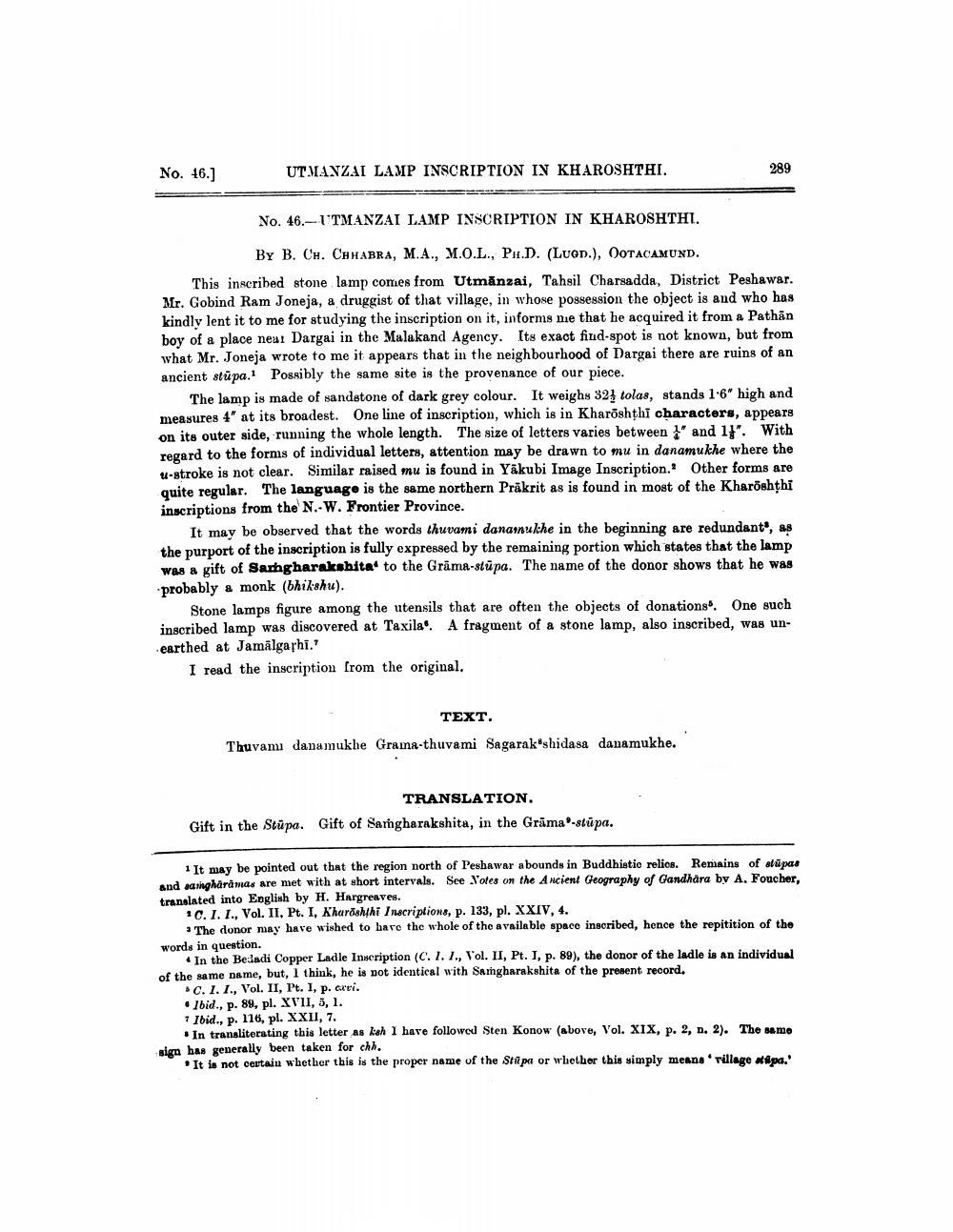________________
No. 46.]
UTMANZAI LAMP INSCRIPTION IN KHAROSHTHI.
289
No. 46.- UTMANZAI LAMP INSCRIPTION IN KHAROSHTHI.
By B. CH. CHHABRA, M.A., M.O.L., PH.D. (LUOD.), OOTACAMUND.
This inscribed stone lamp comes from Utmănzai, Tahsil Charsadda, District Peshawar. Mr. Gobind Ram Joneja, a druggist of that village, in whose possession the object is and who has kindly lent it to me for studying the inscription on it, informs nie that he acquired it from a Pathan boy of a place near Dargai in the Malakand Agency. Its exact find-spot is not known, but from what Mr. Joneja wrote to me it appears that in the neighbourhood of Dargai there are ruins of an ancient stūpa. Possibly the same site is the provenance of our piece.
The lamp is made of sandstone of dark grey colour. It weighs 32 tolas, stands 1.6" high and measures 4" at its broadest. One line of inscription, which is in Kharoshthi characters, appears on its outer side, running the whole length. The size of letters varies between 1 and 13". With regard to the forms of individual letters, attention may be drawn to mu in danamukhe where the u-stroke is not clear. Similar raised mu is found in Yâkubi Image Inscription. Other forms are quite reguler. The language is the same northern Prākrit as is found in most of the Kharoshthi inscriptions from the N.-W. Frontier Province.
It may be observed that the words thuvami dananukhe in the beginning are redundant, as the purport of the inscription is fully expressed by the remaining portion which states that the lamp was a gift of Samgharakshita' to the Gráma-stūpa. The name of the donor shows that he was probably a monk (bhikshu).
Stone lamps figure among the utensils that are often the objects of donations. One such inscribed lamp was discovered at Taxila. A fragment of a stone lamp, also inscribed, was unearthed at Jamālgarhi.'
I read the inscription from the original.
TEXT. Thuvamı dana mukhe Grama-thuvami Sagarakshidasa danamukhe.
TRANSLATION. Gift in the Stupa. Gift of Samgharakshita, in the Grāma-stupa.
1 It may be pointed out that the region north of Peshawar abounds in Buddhistio relios. Remains of stūpas and sangharamas are met with at short intervals. See Yotes on the Ancient Geography of Gandhara by A. Foucher, translated into English by H. Hargreaves.
10.1. I., Vol. II, Pt. I, Kharoshthi Inscriptions, p. 133, pl. XXIV, 4.
• The donor may have wished to have the whole of the available space inscribed, hence the repitition of the words in question.
• In the Beladi Copper Ladle Inscription (C. 1. 1., Vol. II, Pt. I, p. 89), the donor of the ladle is an individual of the same name, but, I think, he is not identical with Sangharakshita of the present record,
*C. 1. I., Vol. II, Pt. I, p. crei. • Ibid., p. 89, pl. XVII, 5, 1. 1 Ibid., p. 116, pl. XXII, 7.
. In transliterating this letter as kah I have followed Sten Konow (above, Vol. XIX, p. 2, n. 2). The same sign has generally been taken for chh.
• It is not certain whether this is the proper name of the Stapa or whether this simply means village aipa.




